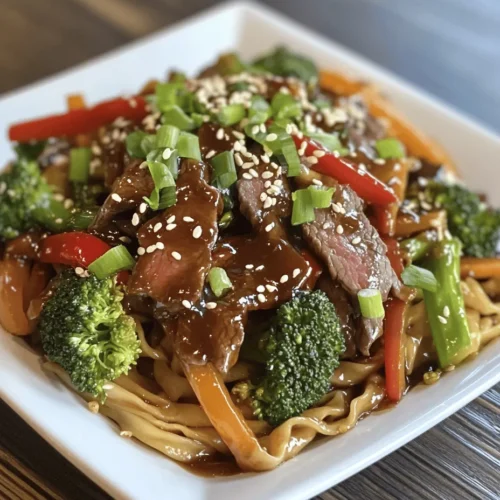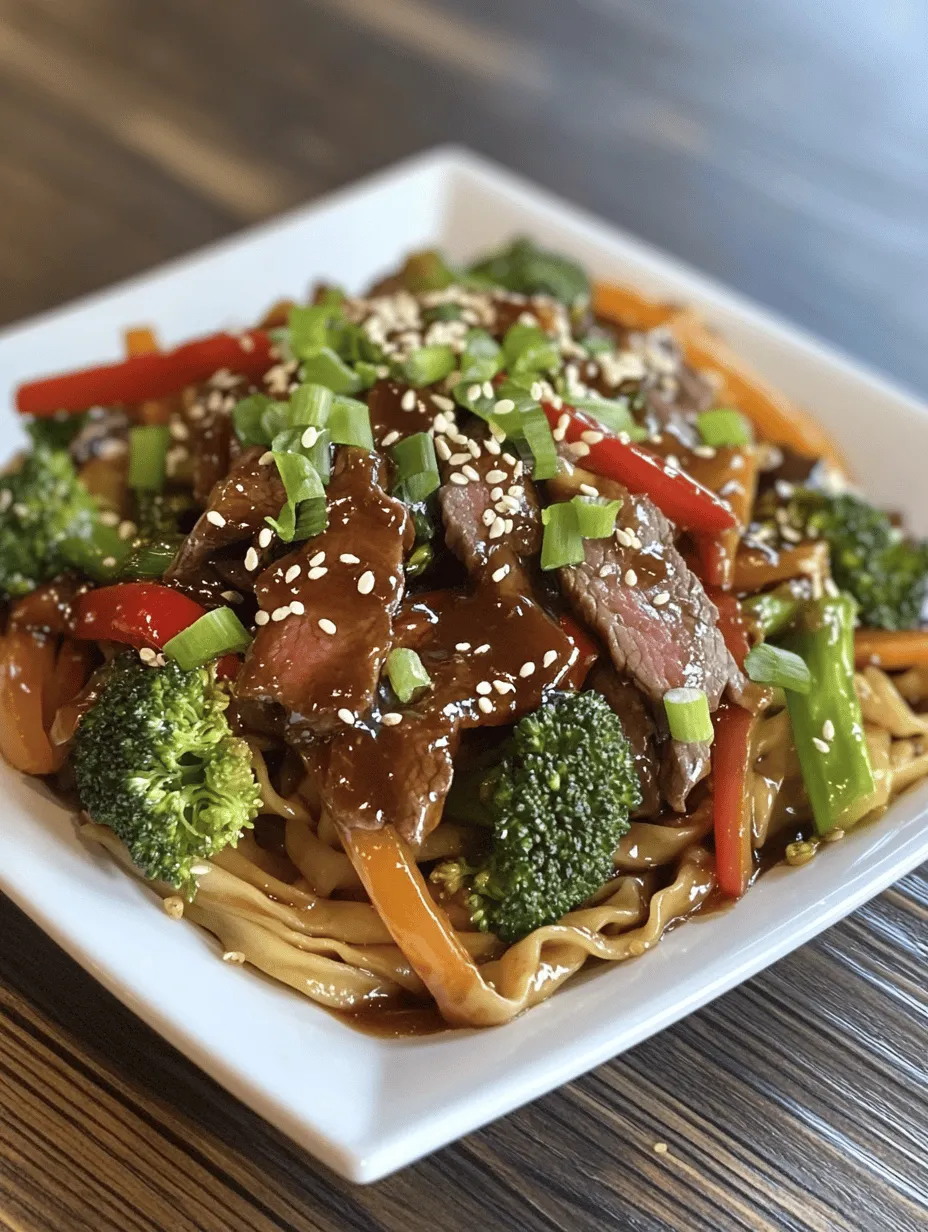Introduction
Savory Beef & Broccoli Lo Mein is a quintessential dish that brings together the bold flavors of Chinese-American cuisine and the comforting familiarity of a home-cooked meal. This dish is not just a feast for the taste buds; it also carries a rich cultural significance, embodying the fusion of traditional Chinese cooking techniques with the preferences of American diners. The combination of tender slices of beef, crisp broccoli, and soft, chewy lo mein noodles creates a delightful balance of textures and flavors that appeals to food lovers of all ages.
What makes Beef & Broccoli Lo Mein especially appealing is its ease of preparation. Perfect for weeknight dinners or casual gatherings, this recipe allows home cooks to whip up a satisfying meal in no time. Whether you’re looking to impress guests or just craving a quick dinner option, this dish delivers on all fronts, making it a reliable choice for any occasion.
Understanding Beef & Broccoli Lo Mein
To appreciate Beef & Broccoli Lo Mein fully, it’s important to understand its historical and cultural context. Lo mein, which translates to “stirred noodles,” has its roots in Chinese culinary tradition. It is believed that the dish originated in the southern regions of China, where fresh wheat noodles are a staple. Over time, as Chinese immigrants settled in America, they adapted their recipes to suit local tastes and ingredients, leading to the creation of what we now recognize as Chinese-American cuisine.
The pairing of beef and broccoli is particularly significant in this adaptation. Broccoli, while not traditionally used in Chinese cuisine, became popular in the United States due to its nutritional benefits and vibrant color. The dish typically features flank steak, which is favored for its rich flavor and tender texture when cooked properly. Together, these ingredients form a dish that is not only visually appealing but also packed with protein and vitamins, making it a hearty option for a meal.
As a result, Beef & Broccoli Lo Mein has become a favorite among food enthusiasts. Its savory flavors and the versatility of its ingredients allow for customization to suit individual tastes. Whether you prefer extra vegetables, a spicier kick, or a different protein altogether, this dish can easily accommodate various preferences, ensuring it remains a beloved staple in many households.
Ingredient Breakdown
Every great recipe starts with high-quality ingredients, and Beef & Broccoli Lo Mein is no exception. Here’s a closer look at the key components that contribute to the dish’s rich flavor profile:
Lo Mein Noodles
The foundation of any lo mein dish is the noodles themselves. Traditionally, lo mein noodles are made from wheat flour and egg, giving them a slightly chewy texture that holds up well against sauces and other ingredients. When selecting lo mein noodles, you can find two primary types: fresh and dried. Fresh noodles will have a softer texture and cook quicker, while dried noodles tend to have a firmer bite. It’s essential to cook the noodles just until al dente, as they will continue to cook when tossed with the stir-fried ingredients.
Flank Steak
Flank steak is the preferred cut for this recipe due to its robust flavor and relatively low fat content. When sliced against the grain, flank steak becomes remarkably tender, making it ideal for stir-frying. Additionally, marinating the beef is a critical step in maximizing its flavor and tenderness. A simple marinade can be created using soy sauce, cornstarch, and a splash of sesame oil, which not only enhances the taste but also helps to tenderize the meat.
Broccoli
Broccoli adds both color and nutrition to this dish. It is rich in vitamins C and K, as well as fiber, making it a healthy addition to your meal. When preparing broccoli for lo mein, it’s best to cut it into bite-sized florets to ensure even cooking. Blanching the broccoli briefly before adding it to the stir-fry helps to retain its vibrant green color and crisp texture.
Variety of Sauces
The flavor of Beef & Broccoli Lo Mein is heavily influenced by the sauces used in the dish. A combination of soy sauce, oyster sauce, and hoisin sauce creates a complex flavor profile that is both savory and slightly sweet. Soy sauce provides the salty umami base, while oyster sauce adds depth and richness. Hoisin sauce, with its sweet and tangy notes, rounds out the experience. For those looking for alternatives or variations, tamari can be used for a gluten-free option or hoisin can be substituted with a homemade blend of soy sauce and sugar.
Fresh Aromatics
No stir-fry is complete without fresh aromatics, and this dish is no exception. Garlic and ginger provide the essential flavor base that elevates the entire dish. Garlic adds a pungent, savory note, while ginger contributes a warm spiciness that complements the beef and broccoli beautifully. When cooking, it’s crucial to add these aromatics early in the process to allow their flavors to infuse the oil, creating a fragrant base for the rest of the ingredients.
Importance of Quality Ingredients
Using high-quality ingredients is vital for achieving the best flavor in your Beef & Broccoli Lo Mein. Fresh vegetables, premium cuts of meat, and authentic sauces can significantly enhance the dish’s overall taste and texture. When you invest in quality ingredients, you not only improve the end result but also make the cooking experience more enjoyable.
Step-by-Step Cooking Instructions
Now that we have an understanding of the ingredients, let’s dive into the step-by-step cooking instructions for creating your own Savory Beef & Broccoli Lo Mein.
Step 1: Preparing the Noodles
Begin by cooking the lo mein noodles according to the package instructions. If you’re using fresh noodles, they typically require only a few minutes of boiling. For dried noodles, you may need to cook them for a longer time. Whichever type you choose, it’s essential to cook them al dente, as this will prevent them from becoming mushy when mixed with the stir-fried ingredients later on. Once cooked, drain the noodles and set them aside for later use.
Step 2: Marinating the Beef
While the noodles are cooking, prepare the beef. Thinly slice the flank steak against the grain to ensure tenderness. In a mixing bowl, combine the sliced beef with soy sauce, cornstarch, and a splash of sesame oil. Allow the beef to marinate for at least 15 minutes. The cornstarch serves a dual purpose: it not only helps to tenderize the meat but also creates a slight coating that will give the beef a nice sear when stir-fried.
Step 3: Blanching the Broccoli
Next, prepare the broccoli. Bring a pot of water to a boil and add the broccoli florets. Blanch them for about 1-2 minutes until they are bright green and slightly tender but still crisp. Immediately transfer the broccoli to an ice bath to stop the cooking process. This step is crucial for maintaining the vibrant color and crunch of the broccoli, which will add both visual appeal and texture to your dish.
Step 4: Stir-Frying the Beef
In a large wok or skillet, heat a tablespoon of vegetable oil over medium-high heat. Once the oil is hot, add the marinated beef in a single layer. Allow the beef to sear without stirring for about 2-3 minutes, as this will create a nice crust. Once the beef is browned, stir-fry it for an additional minute until fully cooked, then remove it from the pan and set it aside.
Step 5: Cooking the Aromatics
In the same wok or skillet, add another drizzle of oil if necessary. Add minced garlic and ginger to the hot oil, stirring quickly to prevent burning. This step will release their aromatic oils, setting the flavor foundation for the dish. Cook the aromatics for about 30 seconds until fragrant, being careful not to let them brown.
Step 6: Combining Ingredients
Now, it’s time to bring everything together. Add the blanched broccoli and cooked lo mein noodles to the wok, along with the stir-fried beef. Drizzle the combination with soy sauce, oyster sauce, and hoisin sauce, tossing everything together to ensure even distribution of flavors. Continue to stir-fry for an additional 2-3 minutes until everything is heated through and well combined.
This initial part of the article sets the stage for a delicious Beef & Broccoli Lo Mein, inviting readers to explore the preparation and cultural significance behind this beloved dish. The next section will delve deeper into cooking tips and common questions, ensuring that readers have all the information they need to create a perfect meal.

Blanching Broccoli: The Science Behind Retaining Color and Texture
Blanching is a crucial step in preparing broccoli for your Beef & Broccoli Lo Mein. This technique involves briefly boiling the broccoli florets and then plunging them into ice water. The scientific rationale here is twofold: it not only helps to preserve the vibrant green color but also maintains the vegetable’s crisp texture. When you blanch broccoli, the boiling water breaks down the cellular structure, allowing it to cook slightly while retaining its nutrients. After about 2-3 minutes of boiling, transfer the florets to an ice bath. This immediate cooling halts the cooking process, locking in the bright color and crunch that will complement the tender beef and soft noodles in your dish.
Making the Stir-Fry Sauce: Balancing Flavors for the Perfect Sauce
The sauce is the heart of your Beef & Broccoli Lo Mein, and achieving the right balance of flavors is essential. Start with a base of soy sauce, which contributes a savory umami flavor. To this, add oyster sauce, which enhances the richness and depth of the dish. A splash of sesame oil adds a nutty aroma, while a pinch of sugar or honey can help balance out the saltiness.
For a touch of acidity, consider adding rice vinegar or fresh lime juice. This contrast will elevate the overall taste profile, making every bite satisfying. Don’t forget to incorporate minced garlic and grated ginger for a fragrant kick.
Mix these ingredients in a bowl until well-combined. The goal is to create a harmonious blend that complements the beef and broccoli, ensuring that every ingredient sings in unison.
Cooking Techniques for Beef: Achieving the Ideal Sear
When it comes to cooking beef for your lo mein, achieving the perfect sear is vital. Begin by slicing your beef thinly against the grain; this will ensure tenderness. Marinate the beef in a mixture of soy sauce, cornstarch, and a splash of sesame oil for about 15-30 minutes. The cornstarch not only adds flavor but also helps create a protective barrier that keeps the meat juicy during cooking.
Heat a wok or large skillet over high heat and add a tablespoon of oil. When the oil starts to shimmer, add the marinated beef in a single layer. Avoid overcrowding the pan, as this will cause the meat to steam rather than sear. Cook for about 2-3 minutes, undisturbed, until the beef develops a golden-brown crust. Flip and sear the other side for an additional minute. Once cooked, remove the beef from the pan and set it aside, letting it rest while you prepare the vegetables.
Stir-Frying Vegetables: Timing and Technique for Perfect Doneness
Stir-frying is all about speed and heat. After removing the beef, add your blanched broccoli and any additional vegetables you’d like, such as bell peppers or carrots, to the hot wok. The high heat will create a slight char and enhance flavors. For perfect doneness, stir-fry the broccoli for about 2-3 minutes; it should be bright green and tender-crisp.
If you’re using onions or bell peppers, add them first as they take longer to cook. Start with these vegetables and stir-fry for a minute or two before adding the broccoli. The key is to keep the vegetables moving in the pan to prevent burning and ensure even cooking.
Combining Ingredients: Ensuring Even Distribution of Sauce and Flavors
Once your vegetables are cooked to perfection, it’s time to bring everything together. Return the beef to the wok along with the prepared stir-fry sauce. Stir gently to coat the beef and vegetables evenly with the sauce. Allow the mixture to cook for an additional 1-2 minutes, letting the sauce thicken and adhere to the ingredients. This final step is crucial for achieving that glossy, restaurant-style finish.
If your lo mein noodles are not already in the mix, now is the time to add them. Toss everything together, ensuring that the sauce envelops each component. Use tongs or a spatula to mix gently, avoiding breaking the noodles while making sure everything is well incorporated.
Final Touches: Importance of Garnishing for Presentation and Taste
Presentation matters, especially with a dish as colorful as Beef & Broccoli Lo Mein. Transfer your completed dish to a serving platter or individual bowls. A sprinkle of sesame seeds adds a delightful crunch and visual appeal. Freshly chopped scallions not only enhance the look but also contribute a fresh, mild onion flavor that brightens the dish.
For an extra touch, a few drops of chili oil or a side of chili paste can be offered for those who enjoy a bit of heat. The final garnishes not only enhance the dish’s aesthetic but also serve to elevate the overall flavor profile.
Nutritional Information
Understanding the nutritional content of your homemade Beef & Broccoli Lo Mein can help you make informed choices. Here’s a breakdown of the nutritional content per serving:
– Calories: Approximately 450
– Protein: 30g
– Fats: 15g
– Carbohydrates: 50g
Health Benefits of Ingredients Used
– Beef: A great source of protein, iron, and essential B vitamins, beef can help support muscle growth and overall health.
– Broccoli: Packed with vitamins C and K, fiber, and antioxidants, broccoli is known for its cancer-fighting properties and supports digestion.
– Noodles: While traditional lo mein noodles are made from refined flour, whole grain options are available for added fiber and nutrients.
Dietary Considerations
For those following a gluten-free diet, substitute soy sauce with tamari or coconut aminos. If vegetarian options are desired, replace beef with tofu or seitan and adjust cooking times accordingly.
Serving Suggestions
To fully enjoy your Beef & Broccoli Lo Mein, consider these ideal accompaniments:
– Side Dishes: Serve your lo mein with crispy egg rolls or savory dumplings. These starters complement the meal perfectly and add variety to the dinner table.
– Beverage Pairings: A light, crisp beverage such as jasmine tea or a refreshing Asian lager can enhance the flavors of the dish. For a non-alcoholic option, try sparkling water with a splash of lime.
Storing and Reheating Suggestions
Proper storage is key to maximizing the lifespan and flavor of your Beef & Broccoli Lo Mein leftovers:
– Storing Leftovers: Allow the dish to cool to room temperature before transferring it to an airtight container. Store in the refrigerator for up to 3-4 days.
– Reheating: To reheat, place the lo mein in a skillet over medium heat with a splash of water or broth to prevent drying. Stir frequently until heated through, ensuring the noodles maintain their texture.
Conclusion
Making Beef & Broccoli Lo Mein at home is not only a rewarding culinary experience but also a delicious way to enjoy a beloved classic. With its vibrant colors, rich flavors, and satisfying textures, this dish is sure to please anyone at your table.
We encourage you to try this recipe and discover how simple it is to recreate restaurant-quality lo mein in your own kitchen. Cooking is a joyful endeavor, and sharing a meal with loved ones is a cherished tradition. So gather your ingredients, channel your inner chef, and enjoy the process of creating something truly special.



